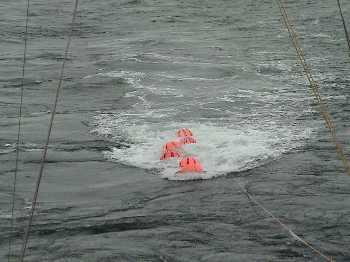7 February, 2004
We are in the midst of our first taste of the cold and bitter weather
that up to now we have had the luxury to avoid. Winds blowing to
the north at 35 to 40 knots, waves of twelve feet or more, and fog
that touched the waves make it feel as though the heavy storm clouds
have encased us in a bowl of perpetual haze for the entire day.
There was little if any relief from the rabid pounding of the waves
that set each of us on our own personal rollercoaster rides as we
walked down the halls or even worse, tried to climb the stairs to the
bridge.
It was put up or shut up time. Did we have our sea legs?
Fortunately, we made it through the day, a bit worse for wear, but
happy to have survived our first test in far rougher seas than we had
seen before. The near constant winds of over 30 knots generated
waves cresting at ten feet or more. The wind and waves pounded the
ship from the seemingly from all sides, forcing the ship's pilot to
constantly adjust our course to stay on our seismic shot lines. We
were being pummeled by the elements. It would be a trial. We hoped
to make it through the day in one piece.
White crests came at the ship seemingly from all directions. From
the bridge, the water took on strange patterns of light and dark.
The sea would appear to be still and calm ahead of the ship for just
an instant, then the ship would be slammed by a wave nearly twice the
size of the rest. It was like dancing with a hippo, slow, pushy, and
never knowing which way to turn to anticipate its' lead.
The seismic equipment also took a pounding. By early morning the
multichannel streamer and the gun array had crossed, locked in a grip
driven by the waves. Both were pulled and tugged in directions that
for which they were not designed. The streamer was having a tough
time staying below the waves. The "birds" that are attached to the
streamer were having a very difficult time keeping it twenty feet
below the streamer.
Extra care was taken during turns to prevent tangling of the guns and
streamer, but because of the rough seas, the only thing that could be
done was to occasionally partially bring in the gun array, and to
dislodge the streamer. This worked, but the waves were persistent
and entangled the gear once we were underway again. Detangling the
streamer would be an added part of the maintenance of the seismic
equipment until we were again in calmer seas.
The multibeam was recording data that looked like it had been run
through a blender. The swaths that we were getting were a jumbled
mess of incoherent lines and colors that did little to represent the
seafloor below. They looked more like the scribbling of an angry
toddler using his or her crayons on the living room wall. The
multibeam was another victim of the rough seas. We could only hope
that we would make it through the day with all hands and all the
equipment in reasonable stead for the next day.
For each of us, our shift couldn't come to an end fast enough. The
endless pounding of the waves drove us to our bunks. Sleep consumed
us. We slept long and hard, hoping the next day would bring us
relief.

Jesse Doran, Jenny White, Ashley Lowe and Jeff Otten discuss options for the seismic streamer in the rough seas.

The buoys on the gun array are pounded by the waves.

Contact the TEA in the field at
.
If you cannot connect through your browser, copy the
TEA's e-mail address in the "To:" line of
your favorite e-mail package.
|
